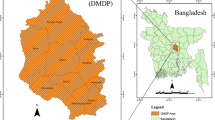Abstract
Proper identification and characterization of sub-soil profile depends on thorough geotechnical investigation. Standard Penetration Test and collection of undisturbed soil samples are age-old common techniques. But from the last decades, it has been observed that there is a major shift in this field. Confidence has been generated more into obtaining results directly from in situ testing. In situ tests (e.g. Cone Penetration Test (CPT), Standard Penetration Test (SPT), and Flat Dilatometer Test (DMT) etc.) are fast, economical and highly informative. Important engineering properties such as undrained cohesion (cu), angle of internal friction (φ) and vertical drained constrained modulus (M) can be estimated by the Flat Dilatometer test with high degree of accuracy. In this paper, the undrained cohesion (cu) and constrained modulus (M) are obtained from Dilatometer Tests and the values have been compared with other field and laboratory test results from three different test sites in Kolkata. Apart from this, two numbers of software, namely DMT Settlement and PLAXIS 2D, were used to draw a comparison on the settlement of the foundation between the estimated value, based on constrained modulus (M) obtained from DMT, CPT tests data and conventional shear strength parameters obtained from conventional boring practices. Finally, it is concluded that geotechnical properties obtained from DMT tests are conservative in nature and settlement obtained from DMT test is well comparable with regard to estimated and observed settlement from other test results. Besides, use of DMT tests reduces overall construction cost and can be performed with confidence in difficult ground condition.

















Similar content being viewed by others
References
Indian Standard (2002) “Method of standard penetration tests for soils”, IS 2131–1981
Indian Standard (2002) “Determination of the shear strength parameters of a specimen tested in unconsolidated undrained triaxial compression without the measurement of pore water pressure”, IS 2720 (11)-1993
Robertson PK, Campanella RG (1983) Interpretation of cone penetration tests. Part I: Sand Canadian Geotech J 20(4):718–733. https://doi.org/10.1139/t83-078
Robertson PK, Campanella RG (1983) Interpretation of cone penetration tests. Part II: Clay Canadian Geotech J 20(4):734–745. https://doi.org/10.1139/t83-078
Robertson PK (2009) Interpretation of cone penetration tests—a unified approach. Can Geotech J 46(11):1337–1355. https://doi.org/10.1139/T09-065
Mayne PW (2007) In-situ test calibrations for evaluating soil parameters. Characterization & Engineering Properties of natural soils. Taylor, Francis, London, pp 1601–1652
Kulhawy, F. H., & Mayne, P. W. (1990). Manual on estimating soil properties for foundation design (No EPRI-EL-6800). Electric Power Research Inst., Palo Alto, CA (USA); Cornell Univ., Ithaca, NY (USA). Geotechnical Engineering Group
Mayne PW (2007) Cone penetration testing. Transportation Research Board, Washington D.C
amiolkowski M, Ghionna VN., Lancellotta R, Pasqualini E (1988) New correlations of penetration tests for design practice. In: Proceeding International Symposium on penetration testing; ISOPT-1, Orlando.1, 263–296
Robertson PK (2009) CPT-DMT Correlations. J Geotech Geoenviron Eng 135(11):1762–1771. https://doi.org/10.1061/(ASCE)GT.1943-5606.0000119
Marchetti S (1980) In situ tests by flat dilatometer. J Geotech Eng Div 106:299–321. https://doi.org/10.1061/AJGEB6.0000934
Marchetti S (1997) The flat dilatometer: design applications. In: Proceeding 3rd International Geotechnical Engineering Conference, Cairo. pp. 421–448.
Marchetti, S., Monaco, P., Totani, G., & Calabrese, M. (2001). The flat dilatometer test (DMT) in soil investigations–A report by the ISSMGE committee TC16. Proc. In Situ, Washington D.C 41
Marchetti DMT home page, https://www.marchetti-dmt.it/
Brinkgreve RBJ, Swolfs WM, Engine E (2002) Plaxis users manual. Balkema, Rotterdam, Netherlands
Motaghedi H, Eslami A (2013) Determining soil shear strength parameters from CPT and CPTu data. Sci Iran Int J Sci Technol 20(5):1349–1360
Onal FO, Özmen G Using Combination of SPT, DMT and CPT to Estimate Geotechnical Model for a Special Project in Turkey.
Aykin K (2009) Comparison of Soil Modelling Using CPT and DMT-A Case Study. Dissertation, Bogazici University. Civil Engineering Istanbul: Turkey
Indian Standard, “Method for subsurface sounding for soils Part III static cone penetration test”, IS 4986 (Part III) -1976, (2002).
Salahudeen AB, Sadeeq JA (2017) Investigation of shallow foundation soil bearing capacity and settlement characteristics of Minna City Centre development site using Plaxis 2D software and empirical formulations. Niger J Technol 36(3):663–670. https://doi.org/10.4314/njt.v36i3
Indian Standard (2006) “Code of practice for design and construction of foundations in soils: general requirements”, IS 1904 -1986
Indian Standard (2003) “Code of practice for calculation of settlements of foundations Part I swallow foundations subjected symmetrical static vertical loads”, IS 8009 (Part I) -1976
Monaco P, Totani G, Calabrese M (2006) DMT-predicted vs observed settlements: a review of the available experience. In Proceeding 2nd international conference on the Flat Dilatometer, Washington DC, pp. 244–252.
Indian Standard (2002) “Code of Practice for Determination of Bearing Capacity of Shallow Foundations”, IS 6403 -1981
Acknowledgements
The authors are highly grateful to Prof. G L S Babu of IISc Bangalore & Prof. S. Mittal of IIT Roorkee for their sincere collaboration and advice at High Court site. The authors express their sincere thanks to M/S L & T Construction, Kolkata, M/S Continental Consultants, Kolkata and M/S M. N. Consultants Pvt. Ltd., Kolkata, for their valuable contributions at Science City project site. Thanks are also due to Studio Prof. Marchetti s.r.l., Rome, Italy, Pagani Geotechnical Equipment, Calendasco, Italy, and BENTLEY EDUCATION for providing assistance at various stages for successful completion of the work.
Author information
Authors and Affiliations
Corresponding author
Ethics declarations
Conflict of interest
On behalf of all authors, the corresponding author states that there is no conflict of interest.
Informed Consent
Informed consent was obtained from all individual contributors involved in this study.
Additional information
Publisher's Note
Springer Nature remains neutral with regard to jurisdictional claims in published maps and institutional affiliations.
Rights and permissions
Springer Nature or its licensor holds exclusive rights to this article under a publishing agreement with the author(s) or other rightsholder(s); author self-archiving of the accepted manuscript version of this article is solely governed by the terms of such publishing agreement and applicable law.
About this article
Cite this article
Bandyopadhyay, K., Das, K., Nandi, S. et al. Dilatometer—an in Situ Soil Exploration Tool for Problematic Ground Conditions vis-à-vis for Economizing Construction Activities. Indian Geotech J 52, 1155–1170 (2022). https://doi.org/10.1007/s40098-022-00655-7
Received:
Accepted:
Published:
Issue Date:
DOI: https://doi.org/10.1007/s40098-022-00655-7




